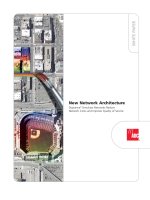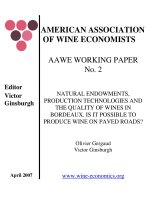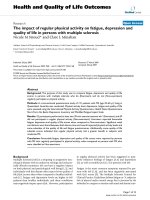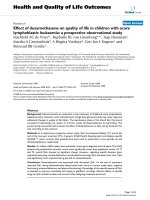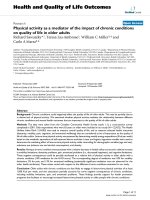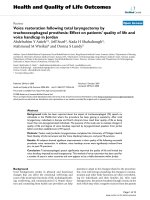ON APPLICATION-PERCEIVED QUALITY OF SERVICE IN WIRELESS NETWORKS
Bạn đang xem bản rút gọn của tài liệu. Xem và tải ngay bản đầy đủ của tài liệu tại đây (2.16 MB, 140 trang )
Blekinge Institute of Technology
Licentiate Dissertation Series No. 2006:11
School of Engineering
ON APPLICATION-PERCEIVED
QUALITY OF SERVICE
IN WIRELESS NETWORKS
Stefan Chevul
Wireless and Mobile Internet have changed the
way people and businesses operate. Communica
-
tion from any Internet access point, including wi
-
reless networks such as UMTS, GPRS or WLAN
has enabled organizations to have a mobile work
-
force. However, networked applications such as
web, email, streaming multimedia etc. rely upon
the ability of timely data delivery. The achievable
throughput is a quality measure for the very task
of a communication system, which is to transport
data in time. Throughput is thus one of the most
essential enablers for networked applications.
While in general, throughput is defined on net
-
work or transport level, the application-perceived
throughput reflects the Quality of Service from
the viewpoints of application and user.
The focus of the thesis is on the influence of the
network on the application-perceived QoS and
thus the user perceived experience. An analysis of
application based active measurements mimicking
the needs of streaming applications is presented.
The results reveal clear influence of the network
on the application-perceived QoS seen from varia
-
tions of application-perceived throughput on small
time scales. Results also indicate that applications
have to cope with considerably large jitter when
trying to use the nominal throughputs. It was ob
-
served that the GPRS network had considerable
problems in delivering packets in downstream di
-
rection even when the nominal capacity of the link
was not reached.
Finally, the thesis discusses the suitability of wire
-
less networks for different mobile services, since
the influence of the network on the application-
perceived Quality of Service is of great significan
-
ce when it comes to customer satisfaction. The
-
refore, application-perceived Quality of Service in
wireless networks must also be considered by the
mobile application programmer during the appli
-
cation development.
ABSTRACT
ISSN 1650-2140
ISBN 91-7295-096-X
2006:11
ON APPLICATION-PERCEIVED QUALITY
OF SERVICE IN WIRELESS NETWORKS
Stefan Chevul
2006:11
On Application-Perceived
Quality of Service
in Wireless Networks
Stefan Chevul
On Application-Perceived
Quality of Service
in Wireless Networks
Stefan Chevul
Blekinge Institute of Technology Licentiate Dissertation Series
No 2006:11
ISSN 1650-2140
ISBN 91-7295-096-X
Department of Telecommunication Systems
School of Engineering
Blekinge Institute of Technology
SWEDEN
© 2006 Stefan Chevul
Department of Telecommunication Systems
School of Engineering
Publisher: Blekinge Institute of Technology
Printed by Kaserntryckeriet, Karlskrona, Sweden 2006
ISBN 91-7295-096-X
c
� 2006 Stefan Chevul
Dissertation Series No. 2006:11
ISSN 1650-2140
ISBN 91-7295-096-X
Department of Telecommunication Systems
School of Engineering
Blekinge Institute of Technology
Printed by Kaserntryckeriet AB, Karlskrona, Sweden
This publication was typeset using L
A
T
E
X.
To my family.
Abstract
Wireless and Mobile Internet have changed the way people and businesses
operate. Communication from any Internet access point, including wireless
networks such as UMTS, GPRS or WLAN has enabled organizations to have
a mobile workforce. However, networked applications such as web, email,
streaming multimedia etc. rely upon the ability of timely data delivery. The
achievable throughput is a quality measure for the very task of a communi-
cation system, which is to transport data in time. Throughput is thus one
of the most essential enablers for networked applications. While in general,
throughput is defined on network or transport level, the application-perceived
throughput reflects the Quality of Service from the viewpoints of the applica-
tion and user.
The focus of the thesis is on the influence of the network on the application-
perceived Quality of Service and thus the user perceived experience. An
analysis of application based active measurements mimicking the needs of
streaming applications is presented. The results reveal clear influence of the
network on the application-perceived Quality of Service seen from variations
of application-perceived throughput on small time scales. Results also indi-
cate that applications have to cope with considerably large jitter when trying
to use the nominal throughputs. It was observed that the GPRS network had
considerable problems in delivering packets in the downstream direction even
when the nominal capacity of the link was not reached.
Finally, the thesis discusses the suitability of wireless networks for different
mobile services, since the influence of the network on the application-perceived
Quality of Service is of great significance when it comes to customer satisfac-
tion. Therefore, application-perceived Quality of Service in wireless networks
must also be considered by the mobile application programmer during the
application development.
vii


